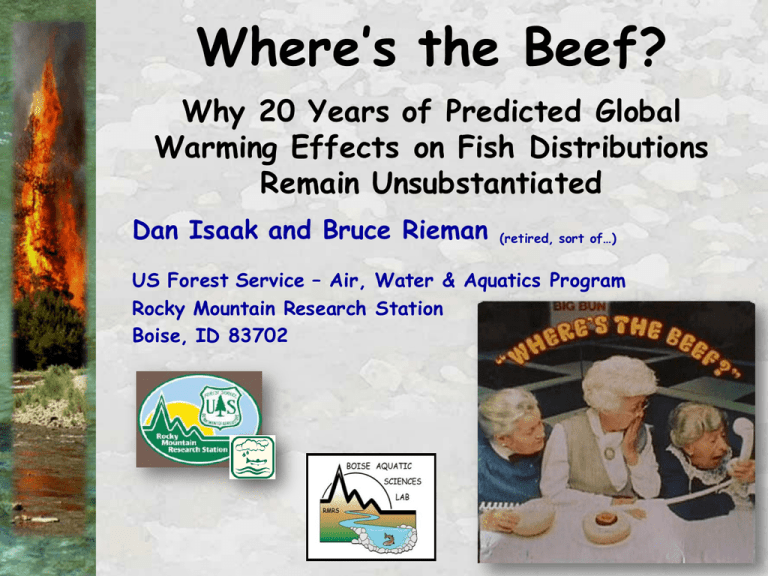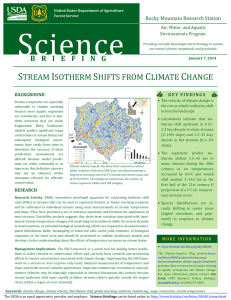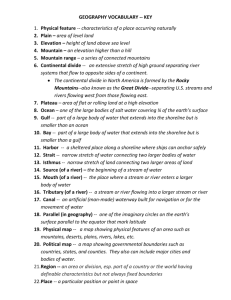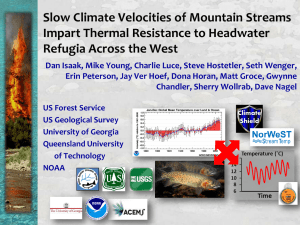Where’s the Beef? Why 20 Years of Predicted Global
advertisement

Where’s the Beef? Why 20 Years of Predicted Global Warming Effects on Fish Distributions Remain Unsubstantiated Dan Isaak and Bruce Rieman (retired, sort of…) US Forest Service – Air, Water & Aquatics Program Rocky Mountain Research Station Boise, ID 83702 Scientific Consensus That Global Warming Would Occur for 30+ Years Peterson et al. 2008. Bull. Amer. Metero. Soc. 1325-1337. Strong Empirical Support for Warming Global Air Temperature Trend +0.8 C during the 20th Century Western U.S. Air Temperature Trends 1950 - 2009 °C/decade Regional Trends In Northwest Rivers Columbia River - Summer Fraser River - Annual ∆ = 0.40°C/decade ∆ = 0.18°C/decade Crozier et al. 2008 Morrison et al. 2002 Snake River, ID - Summer 20 15 1979 Missouri River, MT - Summer 20 ∆ = 0.27°C/decade 1989 1999 2009 15 1979 ∆ = 0.33°C/decade 1989 Isaak et al. 2011. Climatic Change 1999 2009 Temperature is Primary Control for Ectotherms Like Fish Temperature & metabolic rates Thermal Niche Brown 2004 In the lab… McMahon et al. 2007 & the field Isaak & Hubert 2004 Are Species Distributions Shifting? Timing Shift Average phenology change +2.3 days/decade No Change Temporal distribution shifts Parmesan and Yohe. 2003. Nature 421:37-42. Shifts in Salmon Migration Timing Median Spring Chinook Migration Dates at Bonneville Distribution of Sockeye Migrations at Lower Granite 1999-2006 Date July Stream Temps at Bonneville 1962-1998 Date Studies… Date •Juanes et al. 2003 •Crozier et al. 2008 •Keefer et al. 2009 •Wedekind & Kung 2010 •Crozier et al. 2011 •Etc. Are Species Distributions Shifting? Elevation Elevation Spatial distribution shifts Time 1 Time 2 Stream Distance Average distribution shift across taxa = 6.1 km/decade poleward OR 6.1 m/decade higher Parmesan and Yohe. 2003. Nature 421:37-42. We’ve Predicted It for 20+ Years… Early brook trout climate assessments Similar climate studies • Meisner 1988, 1990 • Eaton & Schaller 1996 • Keleher & Rahel 1996 • Rahel et al. 1996 • Mohseni et al. 2003 • Flebbe et al. 2006 • Rieman et al. 2007 • Kennedy et al. 2008 • Williams et al. 2009 • Isaak et al. 2010 • Wenger et al. 2011 • Etc. Meisner et al. 1988. Fisheries 13(3):2-8; Meisner 1990. CJFAS 47:1065-1070 Biological Validation Doesn’t Exist Fact or Fiction? Elevation Climate Boogeyman Traditional sampling Climate sampling Thermal niche boundary at critical isotherm There’s A Lot on the Line Climate Boogeyman Recreational Fisheries High Water Temperature In Grande Ronde Kills 239 Adult Spring Chinook Columbia Basin Bulletin, August 14, 2009 (PST) Land Use & Water Development ESA Listed Species Western Trout Climate Assessment Fish survey database ~10,000 sites Historic Distributions Species-Specific Habitat Response Curves Wenger et al. 2011. Proc. Nat. Acad. Sciences GCM Distributions for IPCC A1B Scenarios 50% Reduction by 2080 Why Doesn’t Biological Validation Exist? We’re not sampling the right places Elevation Traditional sampling Why Doesn’t Biological Validation Exist? Elevation Need to sample across thermal boundaries Climate sampling Thermal niche boundary at critical isotherm What is an Isotherm? How Does it Apply to Streams? Line connecting locations with equal temperatures Plan view Elevation Longitudinal view 14 °C isotherm 16 °C isotherm 18 °C isotherm Distance Salmon River FLIR profile Key BioClimate Model Assumption: Time 1 16 °C isotherm Elevation Elevation Critical isotherm delimits population boundary & populations will track this isotherm Time 2 16 °C isotherm Stream Distance Regional BioClimatic Model Predictions are Not Testable Temperature isotherms mapped instead of fish distributions Trout Density Too Hot OR Statistically imprecise •Bull trout lower elevation limit x = 1,567m, 95% CI = 172m •52 years for detectable range shift (assuming +0.2 C/decade) PRISM Rieman et al. 2007 Stream-Specific Predictions of Isotherm Shifts Needed for Precision Elevation 1) Stream temperature lapse rate (°C / 100 m) 2) Long-term stream warming rate (°C / decade) 3) Stream slope (degrees) 4) Stream sinuosity 16 °C isotherm 16 °C isotherm Stream Distance A Use for High School Trigonometry! 1. Calculate vertical displacement for a given stream lapse rate and long-term warming rate. Displacement (a) = Warming rate Lapse rate 0.2⁰C/decade = 0.4⁰C/100m = +50m/decade 2. Translate displacement to distance along stream of a given slope. a Slope = distance (c) c sin A⁰ a ⁰ A 3. Multiply slope distance by stream sinuosity ratio in meandering streams. c’ c Isotherm shift rate (km/decade) Isotherm Shift Rate Curves Stream lapse rate = 0.4 °C / 100 m Stream warming rate 409.6 +0.1 C/decade (y = 2.50x-1) +0.2 C/decade (y = 5.00x-1) +0.3 C/decade (y = 7.50x-1) +0.4 C/decade (y = 10.0x-1) +0.5 C/decade (y = 12.5x-1) 204.8 102.4 51.2 25.6 12.8 6.4 3.2 1.6 0.8 0.4 Mountain Stream 0.2 0.1 0.1 0.2 0.4 0.8 1.6 3.2 Stream slope (%) 6.4 12.8 Isaak & Rieman, In prep. for Global Change Biology Isotherm shift rate (km/decade) Isotherm Shift Rate Curves Stream lapse rate = 0.4 °C / 100 m Stream warming rate 409.6 204.8 102.4 x Sinuosity multiplier 51.2 25.6 12.8 +0.1 C/decade (y = 2.50x-1) +0.2 C/decade (y = 5.00x-1) +0.3 C/decade (y = 7.50x-1) +0.4 C/decade (y = 10.0x-1) +0.5 C/decade (y = 12.5x-1) 6.4 3.2 1.6 0.8 0.4 Plains Stream 0.2 0.1 0.1 0.2 0.4 0.8 1.6 3.2 Stream slope (%) 6.4 12.8 Isaak & Rieman, In prep. for Global Change Biology Isotherm shift rate (km/decade) Isotherm Shift Rate Curves Stream lapse rate = 0.8 °C / 100 m Stream warming rate 409.6 +0.1 C/decade +0.2 C/decade +0.3 C/decade +0.4 C/decade +0.5 C/decade 204.8 102.4 51.2 25.6 12.8 (y = 1.25x-1) (y = 2.50x-1) (y = 3.75x-1) (y = 5.00x-1) (y = 6.25x-1) 6.4 3.2 1.6 0.8 0.4 0.2 0.1 0.1 0.2 0.4 0.8 1.6 3.2 Stream slope (%) 6.4 12.8 Isaak & Rieman, In prep. for Global Change Biology Mapping Climate Change “Velocity” Long-term stream warming rate = 0.2°C/decade Stream lapse rate = 0.4 °C / 100 m ISR (km/decade) Boise River Network sensu Loarie et al. 2009. Nature 462:1052-1055. Climate Vulnerability & Physiography Trouble? Elevational Refuge Latitudinal Refuge Climate Vulnerability & Physiography Trouble? Elevational Refuge Latitudinal Refuge Precise Isotherm Shift Predictions Elevation Is it a problem? Precise Isotherm Shift Predictions Is it a problem? How much time left on the clock? Elevation Headwater populations with < 10 stream km in trouble by 2050 x years until thermally suitable habitat disappears Longitudinal surveys to map population boundaries & establish baseline Time 1 Thermal niche boundary Resurvey to track population boundary Elevation Elevation Biological Monitoring Implications Time 2 Measure Shift Between Surveys Logistic Regressions of Occurrence Elevation Species Occurrence Survey @ Survey @ time 1 time 2 Tingley & Bessinger. 2009. Detecting range shifts from historical species occurrences.TREE 24:625-633. Power Analysis for Trend Detection Temperature How long would monitoring have to occur? Streams differ in thermal variation & this variation partially masks climate signal that populations receive Elevation Year Stream Summer SD Annual SD NFK Clearwater 1.41 0.70 Fir Creek 0.82 0.51 Missouri R. 1.17 0.64 SFK Bull River 0.86 0.55 NFK Bull River 0.36 0.44 Bull River 0.82 0.58 Isaak et al. 2011. Climatic Change 16 °C isotherm +/- CI Stream Distance Power Curves for Isotherm Shifts Stream lapse rate = 0.4 °C / 100 m Stream slope = 4% Decades for statistically significant isotherm shift 10 St. Dev. of Stream Temperature 9 8 May take a minimum of 20 years to detect population boundary shift, but may be much longer in some streams. 7 6 5 4 0.5 1 1.5 2 3 2 1 0 0 5 Realistic ISRs for 4% channels 10 15 20 25 30 ISR (stream km/decade) Isaak & Rieman, In Prep. Global Change Biology Power Curves for Isotherm Shifts Stream lapse rate = 0.4 °C / 100 m Stream slope = 1% Decades for statistically significant isotherm shift 10 St. Dev. of Stream Temperature 9 8 0.5 1 1.5 2 7 6 5 4 3 2 1 0 0 5 Realistic ISRs for 1% channels 10 15 20 25 30 ISR (stream km/decade) Isaak & Rieman, In Prep. Global Change Biology Empirical Evidence in the Short-Term Resample stream profiles from 20+ years ago Broad Distributional Resurveys Thermal Suitability Assess site extirpation/colonization frequencies relative to temperature Temperature t1 1 Beever et al. 2003; 2010 t2 0 Site occupancy Broad Distributional Resurveys Assess site extirpation/colonization frequencies relative to temperature Fish survey database ~10,000 sites Platts 70’s/80’s Bjornn 1960’s/70’s t1 1 t2 0 Site occupancy Wenger et al. 2011. PNAS Conclusions/Discussion •Estimates of biological shift rates is the “X Prize” and critical information necessary to facilitate accurate climate risk assessments & empower managers to make tough decisions. •Monitoring efforts should focus on streams with fast ISRs and low thermal variance. Detection of biological shifts will require a minimum of 20 years (but could be much longer). •Resurveys of historical sites are needed to provide empirical evidence of biological shifts in near future. •Headwater populations that occupy < 10 km of stream & lack upstream elevational refuges may be extirpated by 2050. •Interesting ecological questions: a) Do shift rates differ between temperature mediated boundaries where populations are allopatric or sympatric (with nonnative competitors)? b) Do shift rates differ at warm (extirpation) or cold (colonization) boundaries? The End







